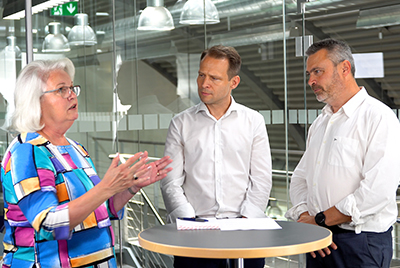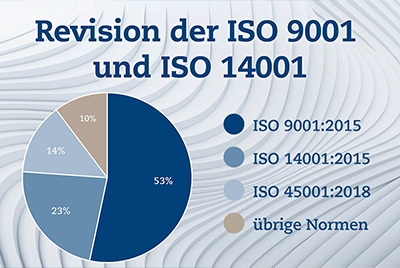Revision of ISO 9001
In 2026, the International Organisation for Standardisation (ISO) will publish a revised version of the world's leading quality management system standard for quality management: ISO 9001. This is the first revision since 2015, which will adapt the standard to changing conditions in the global business environment and at the same time specifically address the current needs of users and other interested parties. The aim is to strengthen the long-term effectiveness of quality management systems and ensure their relevance for future challenges.
Key expected changes in ISO 9001:2026
The changes outlined below relate to the «DIS» status (see schedule and transition further down in this document) and may change until the publication of the new ISO 9001:2026, but not to an extent that is expected to be significant.
-
Alignment with the currently valid Harmonised Structure (HS) for ISO Management System Standards (MSS) to standardise terminology and structure. As part of the revision, requests for changes to the HS were also submitted, which are now being reviewed by a higher-level ISO committee.
-
Revision and clarification of existing requirements to make them more practical and easier to understand. (Chapter 4 – 10).
-
Permanent integration of the supplement to climate-related measures introduced in 2024. (Chapter 4.1, 4.2) (ISO 14001:2015/Amd1:2024).
-
New requirement for the top management to promote a quality culture and ethical behaviour (Chapter 5.1.1), with reference to the chapters 7.1.4 Environment for the operation of processes, 7.3 Awareness as well as described in detail in the appendix A.5.1, A.5.2, A.7.3
-
A more comprehensive description of the requirements for the strategic orientation of an organisation in the appendices A.2, A.4.1, A.6.1.1, A.6.2.
-
Division of the chapter 6.1 Actions to address risks and opportunities into two chapters: 6.1.2 Actions for dealing with risks and chapter 6.1.3 Actions to take advantage of opportunities, to express that these topics should be given equal weight.
-
In chapter 7.2, Competence, documented proof of competencies is now required.
-
Revised and expanded guidelines in Appendix A for a better understanding of the key requirements.
As things stand at present, these are generally moderate adjustments without a fundamental reorientation.
ISO Revision Procedure
The updating and further development of ISO management system standards follow a clearly structured, international process based on the ISO directives. The aim is to ensure that standards always meet current practical requirements, stakeholder expectations, and global challenges.
A key element is the mandatory review of every ISO management system standard no later than five years after its publication. As part of this review, a decision is made as to whether the standard should be confirmed, amended, revised or withdrawn. This decision is based on a comprehensive analysis of its application to date and feedback from the field.
Valuable inputs are provided by the international user surveys conducted by the Technical Committees. These surveys capture the experiences, strengths, weaknesses and needs of users and stakeholders worldwide. The results of the surveys are directly incorporated into the decision-making process for the further development of the standards.
A further step is the «ISO Design Specification Process». Here, the scope, project plan and framework conditions for each revision are defined. The «Design Specification» is internationally coordinated and contains the framework and requirements for the actual revision of the standard for the appointed expert group.
After completion of each revision, a final review is carried out. This review checks whether the defined objectives have been achieved and what insights have been gained from the revision process. These learning experiences are documented and serve as a basis for future improvements in the standardisation process.
These systematic and transparent mechanisms ensure that ISO management system standards are continuously developed and adapted to new challenges – in the interest of all certified organizations and their stakeholders.
Publications and transitional arrangements
The International Accreditation Forum (IAF) will publish binding guidelines for the conversion of existing certificates to the revised standard. SQS will inform its customers as soon as the relevant information is available. The transition period is usually three years.
|
Milestone |
ISO 9001:2026 |
|
Draft standard (DIS) |
August 2025 |
|
Publication of final draft standard (FDIS) |
March – June 2026 |
|
Publication of standard (IS) |
September – November 2026 |
|
Transition periods of IAF |
Not yet known |
Draft Amendmend (DAM), Draft International Standard (DIS), Final Draft International Standard (FDIS), Internationaler Standard (IS)
In Switzerland, the new standards can be obtained and licensed from the Swiss Standards Association (SNV) once they have been published.
They are an important basis for users to further develop their management system.
Conversion of the management system
To prepare for the changeover to the new standard, we recommend that our customers take the following steps:
#1 – Check changes
Get an early overview of the changes in the revised standard, for example from the FDIS (Final Draft International Standard) stage onwards.
#2 – Observe the Deadline
From the date of publication of the new standard, a transition period of three years generally applies. SQS customers may make the adjustment of their certification documents as part of a regular surveillance, recertification or extraordinary surveillance audit. A certain additional effort must be expected for the assessment of the changed requirements.
#3 – Promote understanding
Ensure that all relevant stakeholders are trained and understand the new features and clarifications.
#4 – Analysis and implementation plan
Analyse potential gaps in the existing management system, derive the necessary measures and develop a structured implementation plan.
#5 – Adjust system
Make the necessary adjustments and update your management system.
#6 – Internal audit
Verify successful implementation as part of your internal audits.
#7 – Plan an audit with SQS
Coordinate the upcoming audit activities with SQS after publication of the IS.

With a deliberately focused range of services, SQS supports its customers in the effective implementation and application of the new requirements:
-
SQS live webinars on standard revision from FDIS level onwards
-
Transition process within the framework of joint audit planning



